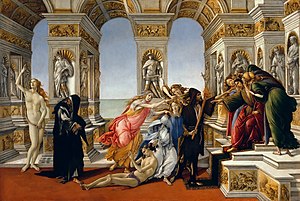The defamation of Apelles

|
| The defamation of Apelles |
|---|
| Sandro Botticelli , 1494-1495 |
| Tempera on wood |
| 62 × 91 cm |
| Uffizi Gallery |
The defamation of Apelles (it. La Calunnia di Apelle ) is an allegorical painting by the Italian painter Sandro Botticelli .
The subject of the picture goes back to the famous description of a lost painting by the ancient painter Apelles , contemporary of Alexander the great , which is handed down in the fourth volume of the writings of Lucian . Botticelli later gave the
picture to his friend Antonio Segni as a gift, presumably not commissioned, and which should be perceived as a bravura piece by potential patrons.
The painting used as a model for Botticelli's picture was painted by Apelles after he had been denounced by his jealous colleague Antiphilos to Ptolemy , a general of Alexander, of being involved in a conspiracy against the king. After it was found out that he was innocent, he painted his picture of the dog-eared King Midas and his advisors in revenge against those involved .
description
On the right side sits on a high throne a king with a scepter and a crown and long donkey ears. With downcast eyes he listens to the whisperings of two women, stupidity and presumption .
In front of the three-tiered throne stands a man wrapped in a tattered hooded cloak, who holds out his left hand accusingly towards the king and with his thin right clasps the hand of a beautiful young woman with a burning torch. It's the hatred and the slander . This pulls an almost naked man by the hair behind him, who has raised his hands pleadingly: It is the accused and slandered Apelles. To slander Two beautiful young women who are striving villainy and - with fluttering pastel-colored robes brought in haste - the fraud , the female in Italian fraude .
Behind this tightly packed group, a thin, ragged woman with a veiled head - personification of repentance - turns to a naked and beautiful young woman who has raised her head and points to heaven, it is the naked truth that has nothing to hide and call heaven as a witness.
The scene takes place in an interior, which is characterized by a magnificent Renaissance architecture. Three passages spanned by barrel vaults and decorated coffered ceilings and supported by mighty pillars allow a view into an indefinite distance. Fighter zone , base and plinth of the pillars are decorated with antique reliefs, the pillars themselves and the back wall of the throne with arched niches and sculptures. The reliefs are scenes from the battle of the centaurs and from the myth of Ariadne and Bacchus . Of the figures, only the one behind the throne can be safely identified as Judith with the head of Holofernes .
Individual evidence
- ↑ Quoted from Schumacher, Andreas: The painter Sandro Botticelli . In: Botticelli. Frankfurt a. M. 2009. p. 15.


